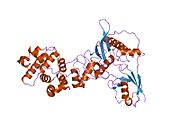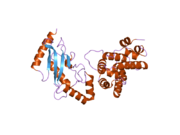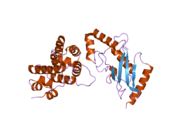UBE2I
UBE2I| UBE2I | |||||||||||||||||||||||||
|---|---|---|---|---|---|---|---|---|---|---|---|---|---|---|---|---|---|---|---|---|---|---|---|---|---|
 | |||||||||||||||||||||||||
| |||||||||||||||||||||||||
| 식별자 | |||||||||||||||||||||||||
| 에일리어스 | UBE2I, C358B7.1, P18, UBC9, 유비퀴틴결합효소 E2I | ||||||||||||||||||||||||
| 외부 ID | OMIM: 601661 MGI: 107365 HomoloGene: 5574 GenCard: UBE2I | ||||||||||||||||||||||||
| |||||||||||||||||||||||||
| |||||||||||||||||||||||||
| |||||||||||||||||||||||||
| |||||||||||||||||||||||||
| 맞춤법 | |||||||||||||||||||||||||
| 종. | 인간 | 마우스 | |||||||||||||||||||||||
| 엔트레즈 | |||||||||||||||||||||||||
| 앙상블 | |||||||||||||||||||||||||
| 유니프로트 | |||||||||||||||||||||||||
| RefSeq(mRNA) | |||||||||||||||||||||||||
| RefSeq(단백질) | |||||||||||||||||||||||||
| 장소(UCSC) | Chr 16: 1.31 ~1.33 Mb | Chr 17: 25.48 ~25.49 Mb | |||||||||||||||||||||||
| PubMed 검색 | [3] | [4] | |||||||||||||||||||||||
| 위키데이터 | |||||||||||||||||||||||||
| |||||||||||||||||||||||||
SMO 결합효소 UBC9은 인체에서 UBE2I 유전자에 [5]의해 암호화되는 효소이다.이것은 또한 때때로 "유비퀴틴 결합 효소 E2I" 또는 "유비퀴틴 캐리어 단백질 9"로 불리기도 하지만, 이러한 이름들이 그 기능을 정확하게 설명하지는 않는다.
표현
이 [6]유전자에 대해 동일한 단백질을 코드하는 4개의 대체 스플라이스 전사 변형이 발견되었다.
기능.
UBE2I 유전자에 의해 코드된 UBC9 단백질은 세포의 섬모일화 경로에서 핵심 기구를 구성한다.수모일화는 작은 유비퀴틴 유사 MOdifier(SUMO)가 다른 단백질의 행동을 수정하기 위해 공유적으로 결합되는 과정이다.예를 들어, 섬오일화는 세포에서 단백질의 국부화, 다른 단백질이나 DNA와 상호작용하는 능력에 영향을 미칠 수 있다.
UBC9는 섬모일화 라이프 사이클의 세 번째 단계인 접합 단계를 수행한다.SMO 단백질 전구체가 최초로 발현되면 먼저 4개의 C 말단 아미노산이 제거되는 숙성 단계를 거치면서 디글리신 모티브가 나타난다.두 번째 단계에서 E1활성화 복합체는 디글리신에서 SMO에 결합해 E2단백 Ubc9에 전달되며, Ubc9의 촉매 포켓 내에서 시스테인 잔기와 티오에스테르 결합을 형성한다.장전된 Ubc9는 이제 다양한 표적 단백질(기질이라고도 함)의 합산을 수행할 준비가 되었습니다.이러한 기질에서 아미노산 잔류물의 특정 모티브를 인식합니다.큰 소수성 잔류물, 리신, 스페이서, 산성 잔류물.이 모티브는 보통 δKxD/E로 약칭됩니다.기판의 인식 모티브 내에 있는 중앙 리신은 촉매 포켓에 삽입됩니다.여기서 SMO의 디글리신의 카르복실 말단은 리신의 γ-아미노기와 펩타이드 결합을 형성한다.이 과정은 E3 리가아제 단백질에 의해 도움을 받을 수 있다.
총산화 과정은 가역적이다.SENP단백질가수분해효소는 SUMO일화단백질에서 SUMO를 제거하여 SUMO일화 반응에 사용할 수 있도록 한다.
임상적 유의성 관련성
UBE2I 유전자에 의해 암호화된 단백질 UBC9는 HIV와 HPV를 포함한 여러 바이러스에 의해 표적이 되는 것으로 나타났다.이들 바이러스가 UBC9를 납치해 자신의 [7]목적을 달성한다는 가설이 있다.
상호 작용
UBE2I는 다음과 상호작용하는 것으로 나타났습니다.
- ATF2,[8]
- 안드로겐 [9]수용체
- BLMH,[10]
- DACH1,[11][12]
- DNMT3A,[13]
- DNMT3B,[14]
- DAXX,[15][16]
- ETS1,[17]
- 히트[18]
- IPO13,[19]
- MAP3K1[20] 및
- MITF,[21]
- P53,[22][23][24][25]
- PIAS1,[26][27][28]
- PIAS2,[11][26]
- RAD51,[22][29]
- RANBP2,[30][31]
- LANGAP1,[15][30][32]
- SAE2,[15][30]
- SALL1,[33]
- 스모1,[22][23][30][32]
- TCF3,[34]
- TNFRSF1A,[20]
- TOP1,[35] 및
- WT1.[36]
메모들
- ^ a b c GRCh38: 앙상블 릴리즈 89: ENSG00000103275 - 앙상블, 2017년 5월
- ^ a b c GRCm38: 앙상블 릴리즈 89: ENSMUSG000015120 - 앙상블, 2017년 5월
- ^ "Human PubMed Reference:". National Center for Biotechnology Information, U.S. National Library of Medicine.
- ^ "Mouse PubMed Reference:". National Center for Biotechnology Information, U.S. National Library of Medicine.
- ^ Watanabe TK, Fujiwara T, Kawai A, Shimizu F, Takami S, Hirano H, Okuno S, Ozaki K, Takeda S, Shimada Y, Nagata M, Takaichi A, Takahashi E, Nakamura Y, Shin S (March 1996). "Cloning, expression, and mapping of UBE2I, a novel gene encoding a human homologue of yeast ubiquitin-conjugating enzymes which are critical for regulating the cell cycle". Cytogenet Cell Genet. 72 (1): 86–9. doi:10.1159/000134169. PMID 8565643.
- ^ "Entrez Gene: UBE2I ubiquitin-conjugating enzyme E2I (UBC9 homolog, yeast)".
- ^ Varadaraj A, Mattoscio D, Chiocca S (Jan 2014). "SUMO Ubc9 enzyme as a viral target". IUBMB Life. 66 (1): 27–33. doi:10.1002/iub.1240. PMID 24395713. S2CID 42047371.
- ^ Firestein R, Feuerstein N (March 1998). "Association of activating transcription factor 2 (ATF2) with the ubiquitin-conjugating enzyme hUBC9. Implication of the ubiquitin/proteasome pathway in regulation of ATF2 in T cells". J. Biol. Chem. 273 (10): 5892–902. doi:10.1074/jbc.273.10.5892. PMID 9488727.
- ^ Poukka H, Aarnisalo P, Karvonen U, Palvimo JJ, Jänne OA (July 1999). "Ubc9 interacts with the androgen receptor and activates receptor-dependent transcription". J. Biol. Chem. 274 (27): 19441–6. doi:10.1074/jbc.274.27.19441. PMID 10383460.
- ^ Koldamova RP, Lefterov IM, DiSabella MT, Lazo JS (Dec 1998). "An evolutionarily conserved cysteine protease, human bleomycin hydrolase, binds to the human homologue of ubiquitin-conjugating enzyme 9". Mol. Pharmacol. 54 (6): 954–61. doi:10.1124/mol.54.6.954. PMID 9855622.
- ^ a b Rual JF, Venkatesan K, Hao T, Hirozane-Kishikawa T, Dricot A, Li N, Berriz GF, Gibbons FD, Dreze M, Ayivi-Guedehoussou N, Klitgord N, Simon C, Boxem M, Milstein S, Rosenberg J, Goldberg DS, Zhang LV, Wong SL, Franklin G, Li S, Albala JS, Lim J, Fraughton C, Llamosas E, Cevik S, Bex C, Lamesch P, Sikorski RS, Vandenhaute J, Zoghbi HY, Smolyar A, Bosak S, Sequerra R, Doucette-Stamm L, Cusick ME, Hill DE, Roth FP, Vidal M (October 2005). "Towards a proteome-scale map of the human protein-protein interaction network". Nature. 437 (7062): 1173–8. Bibcode:2005Natur.437.1173R. doi:10.1038/nature04209. PMID 16189514. S2CID 4427026.
- ^ Machon O, Backman M, Julin K, Krauss S (October 2000). "Yeast two-hybrid system identifies the ubiquitin-conjugating enzyme mUbc9 as a potential partner of mouse Dac". Mech. Dev. 97 (1–2): 3–12. doi:10.1016/s0925-4773(00)00402-0. PMID 11025202. S2CID 14154139.
- ^ Ling Y, Sankpal UT, Robertson AK, McNally JG, Karpova T, Robertson KD (2004). "Modification of de novo DNA methyltransferase 3a (Dnmt3a) by SUMO-1 modulates its interaction with histone deacetylases (HDACs) and its capacity to repress transcription". Nucleic Acids Res. 32 (2): 598–610. doi:10.1093/nar/gkh195. PMC 373322. PMID 14752048.
- ^ Kang ES, Park CW, Chung JH (Dec 2001). "Dnmt3b, de novo DNA methyltransferase, interacts with SUMO-1 and Ubc9 through its N-terminal region and is subject to modification by SUMO-1". Biochem. Biophys. Res. Commun. 289 (4): 862–8. doi:10.1006/bbrc.2001.6057. PMID 11735126.
- ^ a b c Knipscheer P, Flotho A, Klug H, Olsen JV, van Dijk WJ, Fish A, Johnson ES, Mann M, Sixma TK, Pichler A (August 2008). "Ubc9 sumoylation regulates SUMO target discrimination". Mol. Cell. 31 (3): 371–82. doi:10.1016/j.molcel.2008.05.022. PMID 18691969.
- ^ Ryu SW, Chae SK, Kim E (Dec 2000). "Interaction of Daxx, a Fas binding protein, with sentrin and Ubc9". Biochem. Biophys. Res. Commun. 279 (1): 6–10. doi:10.1006/bbrc.2000.3882. PMID 11112409.
- ^ Hahn SL, Wasylyk B, Criqui-Filipe P, Criqui P (September 1997). "Modulation of ETS-1 transcriptional activity by huUBC9, a ubiquitin-conjugating enzyme". Oncogene. 15 (12): 1489–95. doi:10.1038/sj.onc.1201301. PMID 9333025. S2CID 26170389.
- ^ Shi Y, Zou M, Farid NR, Paterson MC (Dec 2000). "Association of FHIT (fragile histidine triad), a candidate tumour suppressor gene, with the ubiquitin-conjugating enzyme hUBC9". Biochem. J. 352 (2): 443–8. doi:10.1042/0264-6021:3520443. PMC 1221476. PMID 11085938.
- ^ Mingot JM, Kostka S, Kraft R, Hartmann E, Görlich D (July 2001). "Importin 13: a novel mediator of nuclear import and export". EMBO J. 20 (14): 3685–94. doi:10.1093/emboj/20.14.3685. PMC 125545. PMID 11447110.
- ^ a b Saltzman A, Searfoss G, Marcireau C, Stone M, Ressner R, Munro R, Franks C, D'Alonzo J, Tocque B, Jaye M, Ivashchenko Y (April 1998). "hUBC9 associates with MEKK1 and type I TNF-alpha receptor and stimulates NFkappaB activity". FEBS Lett. 425 (3): 431–5. doi:10.1016/s0014-5793(98)00287-7. PMID 9563508. S2CID 84816080.
- ^ Xu W, Gong L, Haddad MM, Bischof O, Campisi J, Yeh ET, Medrano EE (March 2000). "Regulation of microphthalmia-associated transcription factor MITF protein levels by association with the ubiquitin-conjugating enzyme hUBC9". Exp. Cell Res. 255 (2): 135–43. doi:10.1006/excr.2000.4803. PMID 10694430.
- ^ a b c Shen Z, Pardington-Purtymun PE, Comeaux JC, Moyzis RK, Chen DJ (October 1996). "Associations of UBE2I with RAD52, UBL1, p53, and RAD51 proteins in a yeast two-hybrid system". Genomics. 37 (2): 183–186. doi:10.1006/geno.1996.0540. PMID 8921390.
- ^ a b Minty A, Dumont X, Kaghad M, Caput D (November 2000). "Covalent modification of p73alpha by SUMO-1. Two-hybrid screening with p73 identifies novel SUMO-1-interacting proteins and a SUMO-1 interaction motif". J. Biol. Chem. 275 (46): 36316–23. doi:10.1074/jbc.M004293200. PMID 10961991.
- ^ Gallagher WM, Argentini M, Sierra V, Bracco L, Debussche L, Conseiller E (June 1999). "MBP1: a novel mutant p53-specific protein partner with oncogenic properties". Oncogene. 18 (24): 3608–16. doi:10.1038/sj.onc.1202937. PMID 10380882.
- ^ Bernier-Villamor V, Sampson DA, Matunis MJ, Lima CD (February 2002). "Structural basis for E2-mediated SUMO conjugation revealed by a complex between ubiquitin-conjugating enzyme Ubc9 and RanGAP1". Cell. 108 (3): 345–56. doi:10.1016/s0092-8674(02)00630-x. PMID 11853669. S2CID 15512250.
- ^ a b Lee BH, Yoshimatsu K, Maeda A, Ochiai K, Morimatsu M, Araki K, Ogino M, Morikawa S, Arikawa J (Dec 2003). "Association of the nucleocapsid protein of the Seoul and Hantaan hantaviruses with small ubiquitin-like modifier-1-related molecules". Virus Res. 98 (1): 83–91. doi:10.1016/j.virusres.2003.09.001. PMID 14609633.
- ^ Sapetschnig A, Rischitor G, Braun H, Doll A, Schergaut M, Melchior F, Suske G (October 2002). "Transcription factor Sp3 is silenced through SUMO modification by PIAS1". EMBO J. 21 (19): 5206–15. doi:10.1093/emboj/cdf510. PMC 129032. PMID 12356736.
- ^ Kahyo T, Nishida T, Yasuda H (September 2001). "Involvement of PIAS1 in the sumoylation of tumor suppressor p53". Mol. Cell. 8 (3): 713–8. doi:10.1016/s1097-2765(01)00349-5. PMID 11583632.
- ^ Kovalenko OV, Plug AW, Haaf T, Gonda DK, Ashley T, Ward DC, Radding CM, Golub EI (April 1996). "Mammalian ubiquitin-conjugating enzyme Ubc9 interacts with Rad51 recombination protein and localizes in synaptonemal complexes". Proc. Natl. Acad. Sci. U.S.A. 93 (7): 2958–63. Bibcode:1996PNAS...93.2958K. doi:10.1073/pnas.93.7.2958. PMC 39742. PMID 8610150.
- ^ a b c d Ewing RM, Chu P, Elisma F, Li H, Taylor P, Climie S, McBroom-Cerajewski L, Robinson MD, O'Connor L, Li M, Taylor R, Dharsee M, Ho Y, Heilbut A, Moore L, Zhang S, Ornatsky O, Bukhman YV, Ethier M, Sheng Y, Vasilescu J, Abu-Farha M, Lambert JP, Duewel HS, Stewart II, Kuehl B, Hogue K, Colwill K, Gladwish K, Muskat B, Kinach R, Adams SL, Moran MF, Morin GB, Topaloglou T, Figeys D (2007). "Large-scale mapping of human protein-protein interactions by mass spectrometry". Mol. Syst. Biol. 3: 89. doi:10.1038/msb4100134. PMC 1847948. PMID 17353931.
- ^ Zhang H, Saitoh H, Matunis MJ (September 2002). "Enzymes of the SUMO modification pathway localize to filaments of the nuclear pore complex". Mol. Cell. Biol. 22 (18): 6498–508. doi:10.1128/mcb.22.18.6498-6508.2002. PMC 135644. PMID 12192048.
- ^ a b Tatham MH, Kim S, Yu B, Jaffray E, Song J, Zheng J, Rodriguez MS, Hay RT, Chen Y (August 2003). "Role of an N-terminal site of Ubc9 in SUMO-1, -2, and -3 binding and conjugation". Biochemistry. 42 (33): 9959–69. doi:10.1021/bi0345283. PMID 12924945.
- ^ Netzer C, Bohlander SK, Rieger L, Müller S, Kohlhase J (August 2002). "Interaction of the developmental regulator SALL1 with UBE2I and SUMO-1". Biochem. Biophys. Res. Commun. 296 (4): 870–6. doi:10.1016/s0006-291x(02)02003-x. PMID 12200128.
- ^ Huggins GS, Chin MT, Sibinga NE, Lee SL, Haber E, Lee ME (October 1999). "Characterization of the mUBC9-binding sites required for E2A protein degradation". J. Biol. Chem. 274 (40): 28690–6. doi:10.1074/jbc.274.40.28690. PMID 10497239.
- ^ Mao Y, Sun M, Desai SD, Liu LF (April 2000). "SUMO-1 conjugation to topoisomerase I: A possible repair response to topoisomerase-mediated DNA damage". Proc. Natl. Acad. Sci. U.S.A. 97 (8): 4046–51. Bibcode:2000PNAS...97.4046M. doi:10.1073/pnas.080536597. PMC 18143. PMID 10759568.
- ^ Wang ZY, Qiu QQ, Seufert W, Taguchi T, Testa JR, Whitmore SA, Callen DF, Welsh D, Shenk T, Deuel TF (October 1996). "Molecular cloning of the cDNA and chromosome localization of the gene for human ubiquitin-conjugating enzyme 9". J. Biol. Chem. 271 (40): 24811–6. doi:10.1074/jbc.271.40.24811. PMID 8798754.
레퍼런스
- Kovalenko OV, Plug AW, Haaf T, Gonda DK, Ashley T, Ward DC, Radding CM, Golub EI (1996). "Mammalian ubiquitin-conjugating enzyme Ubc9 interacts with Rad51 recombination protein and localizes in synaptonemal complexes". Proc. Natl. Acad. Sci. U.S.A. 93 (7): 2958–63. Bibcode:1996PNAS...93.2958K. doi:10.1073/pnas.93.7.2958. PMC 39742. PMID 8610150.
- Jiang W, Koltin Y (1996). "Two-hybrid interaction of a human UBC9 homolog with centromere proteins of Saccharomyces cerevisiae". Mol. Gen. Genet. 251 (2): 153–60. doi:10.1007/s004380050152. PMID 8668125.
- Yasugi T, Howley PM (1996). "Identification of the structural and functional human homolog of the yeast ubiquitin conjugating enzyme UBC9". Nucleic Acids Res. 24 (11): 2005–10. doi:10.1093/nar/24.11.2005. PMC 145898. PMID 8668529.
- Göttlicher M, Heck S, Doucas V, Wade E, Kullmann M, Cato AC, Evans RM, Herrlich P (1996). "Interaction of the Ubc9 human homologue with c-Jun and with the glucocorticoid receptor". Steroids. 61 (4): 257–62. doi:10.1016/0039-128X(96)00032-3. PMID 8733011. S2CID 11608979.
- Schneikert J, Peterziel H, Defossez PA, Klocker H, de Launoit Y, Cato AC (1996). "Androgen receptor-Ets protein interaction is a novel mechanism for steroid hormone-mediated down-modulation of matrix metalloproteinase expression". J. Biol. Chem. 271 (39): 23907–13. doi:10.1074/jbc.271.39.23907. PMID 8798622.
- Wang ZY, Qiu QQ, Seufert W, Taguchi T, Testa JR, Whitmore SA, Callen DF, Welsh D, Shenk T, Deuel TF (1996). "Molecular cloning of the cDNA and chromosome localization of the gene for human ubiquitin-conjugating enzyme 9". J. Biol. Chem. 271 (40): 24811–6. doi:10.1074/jbc.271.40.24811. PMID 8798754.
- Hateboer G, Hijmans EM, Nooij JB, Schlenker S, Jentsch S, Bernards R (1996). "mUBC9, a novel adenovirus E1A-interacting protein that complements a yeast cell cycle defect". J. Biol. Chem. 271 (42): 25906–11. doi:10.1074/jbc.271.42.25906. PMID 8824223.
- Shen Z, Pardington-Purtymun PE, Comeaux JC, Moyzis RK, Chen DJ (1997). "Associations of UBE2I with RAD52, UBL1, p53, and RAD51 proteins in a yeast two-hybrid system". Genomics. 37 (2): 183–6. doi:10.1006/geno.1996.0540. PMID 8921390.
- Tachibana M, Iwata N, Watanabe A, Nobukuni Y, Ploplis B, Kajigaya S (1997). "Assignment of the gene for a ubiquitin-conjugating enzyme (UBE2I) to human chromosome band 16p13.3 by in situ hybridization". Cytogenet. Cell Genet. 75 (4): 222–3. doi:10.1159/000134487. PMID 9067428.
- Masson M, Menissier-de Murcia J, Mattei MG, de Murcia G, Niedergang CP (1997). "Poly(ADP-ribose) polymerase interacts with a novel human ubiquitin conjugating enzyme: hUbc9". Gene. 190 (2): 287–96. doi:10.1016/S0378-1119(97)00015-2. PMID 9197546.
- Yasugi T, Vidal M, Sakai H, Howley PM, Benson JD (1997). "Two classes of human papillomavirus type 16 E1 mutants suggest pleiotropic conformational constraints affecting E1 multimerization, E2 interaction, and interaction with cellular proteins". J. Virol. 71 (8): 5942–51. doi:10.1128/JVI.71.8.5942-5951.1997. PMC 191850. PMID 9223484.
- Becker K, Schneider P, Hofmann K, Mattmann C, Tschopp J (1997). "Interaction of Fas(Apo-1/CD95) with proteins implicated in the ubiquitination pathway". FEBS Lett. 412 (1): 102–6. doi:10.1016/S0014-5793(97)00758-8. PMID 9257699. S2CID 689407.
- Tong H, Hateboer G, Perrakis A, Bernards R, Sixma TK (1997). "Crystal structure of murine/human Ubc9 provides insight into the variability of the ubiquitin-conjugating system". J. Biol. Chem. 272 (34): 21381–7. CiteSeerX 10.1.1.531.2567. doi:10.1074/jbc.272.34.21381. PMID 9261152. S2CID 45098033.
- Hahn SL, Wasylyk B, Criqui-Filipe P, Criqui P (1997). "Modulation of ETS-1 transcriptional activity by huUBC9, a ubiquitin-conjugating enzyme". Oncogene. 15 (12): 1489–95. doi:10.1038/sj.onc.1201301. PMID 9333025. S2CID 26170389.
- Hu G, Zhang S, Vidal M, Baer JL, Xu T, Fearon ER (1997). "Mammalian homologs of seven in absentia regulate DCC via the ubiquitin–proteasome pathway". Genes Dev. 11 (20): 2701–14. doi:10.1101/gad.11.20.2701. PMC 316613. PMID 9334332.
- Firestein R, Feuerstein N (1998). "Association of activating transcription factor 2 (ATF2) with the ubiquitin-conjugating enzyme hUBC9. Implication of the ubiquitin/proteasome pathway in regulation of ATF2 in T cells". J. Biol. Chem. 273 (10): 5892–902. doi:10.1074/jbc.273.10.5892. PMID 9488727.
- Joanisse DR, Inaguma Y, Tanguay RM (1998). "Cloning and developmental expression of a nuclear ubiquitin-conjugating enzyme (DmUbc9) that interacts with small heat shock proteins in Drosophila melanogaster". Biochem. Biophys. Res. Commun. 244 (1): 102–9. doi:10.1006/bbrc.1998.8214. PMID 9514881.
- Saltzman A, Searfoss G, Marcireau C, Stone M, Ressner R, Munro R, Franks C, D'Alonzo J, Tocque B, Jaye M, Ivashchenko Y (1998). "hUBC9 associates with MEKK1 and type I TNF-alpha receptor and stimulates NFkappaB activity". FEBS Lett. 425 (3): 431–5. doi:10.1016/S0014-5793(98)00287-7. PMID 9563508. S2CID 84816080.
- Koldamova RP, Lefterov IM, DiSabella MT, Lazo JS (1999). "An evolutionarily conserved cysteine protease, human bleomycin hydrolase, binds to the human homologue of ubiquitin-conjugating enzyme 9". Mol. Pharmacol. 54 (6): 954–61. doi:10.1124/mol.54.6.954. PMID 9855622.





















